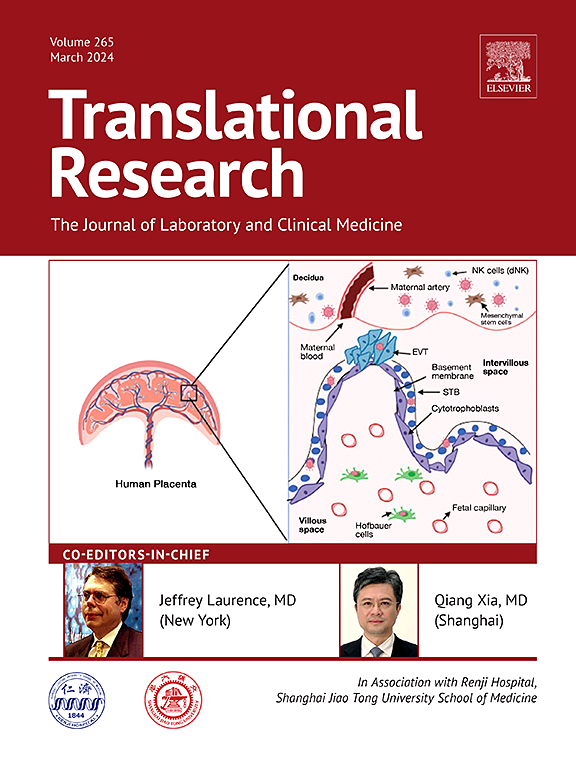整合生物标志物/细胞因子、临床和代谢组学数据的ARDS死亡率预测模型。
IF 5.9
2区 医学
Q1 MEDICAL LABORATORY TECHNOLOGY
引用次数: 0
摘要
急性呼吸窘迫综合征(ARDS)的特点是呼吸衰竭发作迅速,死亡率约为40%,仍然是重症监护医学的一个重大挑战。尽管支持治疗取得了进展,但ARDS死亡率的准确预测仍然具有挑战性,导致有针对性的干预措施和有效的疾病管理延迟交付。传统的危重疾病严重程度评分对ARDS缺乏特异性,强调需要更精确的ARDS死亡率预后工具。为了解决这一关键的差距,我们采用了一种多模式方法来预测ARDS患者,利用由ARDS患者的综合临床、代谢组学和生化/细胞因子数据组成的综合数据集(在ICU入院数小时内收集)来建立和验证ARDS死亡率风险的预测模型。生成的最稳健的多模态数据模型显示出较好的预测能力,测试集的曲线下面积(AUC)为0.868,验证集的AUC为0.959。值得注意的是,该模型在识别验证队列中的非幸存者方面具有完美的特异性,突出了在ICU环境中指导早期和有针对性干预的潜在效用。代谢组学分析显示,与色氨酸代谢相关的关键途径,特别是犬尿氨酸途径,以及NAD+代谢/烟酰胺磷酸核糖基转移酶(NAMPT)和糖胺聚糖生物合成途径发生了显著变化。猪脓毒症/ARDS模型肺组织的脂质组学/代谢组学分析有力地证实了这些代谢紊乱。总之,这些发现表明,整合多模式数据有望改善ARDS预后,并为了解严重ARDS的复杂代谢紊乱提供重要见解。识别代谢特征,如犬尿氨酸和NAD+代谢/NAMPT途径,可能为制定针对ARDS患者的个性化和有效的靶向干预和管理策略奠定基础。本文章由计算机程序翻译,如有差异,请以英文原文为准。
Predictive modeling of ARDS mortality integrating biomarker/cytokine, clinical and metabolomic data
Acute Respiratory Distress Syndrome (ARDS), characterized by the rapid onset of respiratory failure and mortality rates of ∼40%, remains a significant challenge in critical care medicine. Despite advances in supportive care, accurate prediction of ARDS mortality remains challenging, resulting in delayed delivery of targeted interventions and effective disease management. Traditional critical illness severity scores lack specificity for ARDS, underscoring the need for more precise prognostic tools for ARDS mortality. To address this crucial gap, we employed a multimodal approach to predict ARDS patients utilizing a comprehensive dataset comprised of integrated clinical, metabolomic, and biochemical/cytokine data from ARDS patients (collected within hours of ICU admission) to develop and validate predictive models of ARDS mortality risk. The most robust multimodal data model generated demonstrated superior predictive capability with an area under the curve (AUC) of 0.868 on the test set and 0.959 on the validation set. Notably, this model achieved perfect specificity in identifying non-survivors in the validation cohort, highlighting potential utility in guiding early and targeted interventions in ICU settings. Metabolomic analysis revealed significant alterations in crucial pathways associated with ARDS mortality with tryptophan metabolism, particularly the kynurenine pathway, emerging as the most significantly enriched metabolic route, as well as the NAD+ metabolism/nicotinamide phosphoribosyltransferase (NAMPT) and glycosaminoglycan biosynthesis pathways. These metabolic derangements were strongly confirmed by lipidomic/metabolomic analysis of lung tissues from a porcine sepsis/ARDS model. Together, these findings demonstrate the promise of integrating multimodal data to improve ARDS prognostication and to provide important insights into the complex metabolic derangements underlying severe ARDS. Identification of metabolic signatures, such as kynurenine and NAD+ metabolism/NAMPT pathways, may serve as a foundation for developing personalized and effective targeted interventions and management strategies for ARDS patients.
求助全文
通过发布文献求助,成功后即可免费获取论文全文。
去求助
来源期刊

Translational Research
医学-医学:内科
CiteScore
15.70
自引率
0.00%
发文量
195
审稿时长
14 days
期刊介绍:
Translational Research (formerly The Journal of Laboratory and Clinical Medicine) delivers original investigations in the broad fields of laboratory, clinical, and public health research. Published monthly since 1915, it keeps readers up-to-date on significant biomedical research from all subspecialties of medicine.
 求助内容:
求助内容: 应助结果提醒方式:
应助结果提醒方式:


